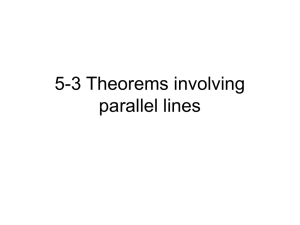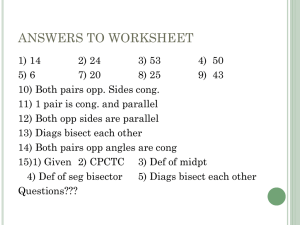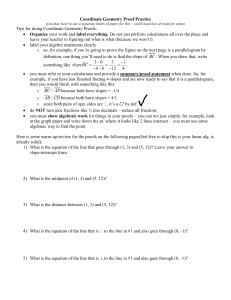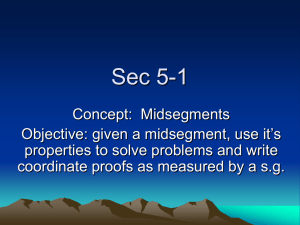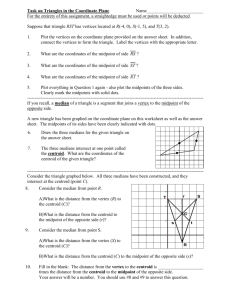Coordinate Proofs
advertisement
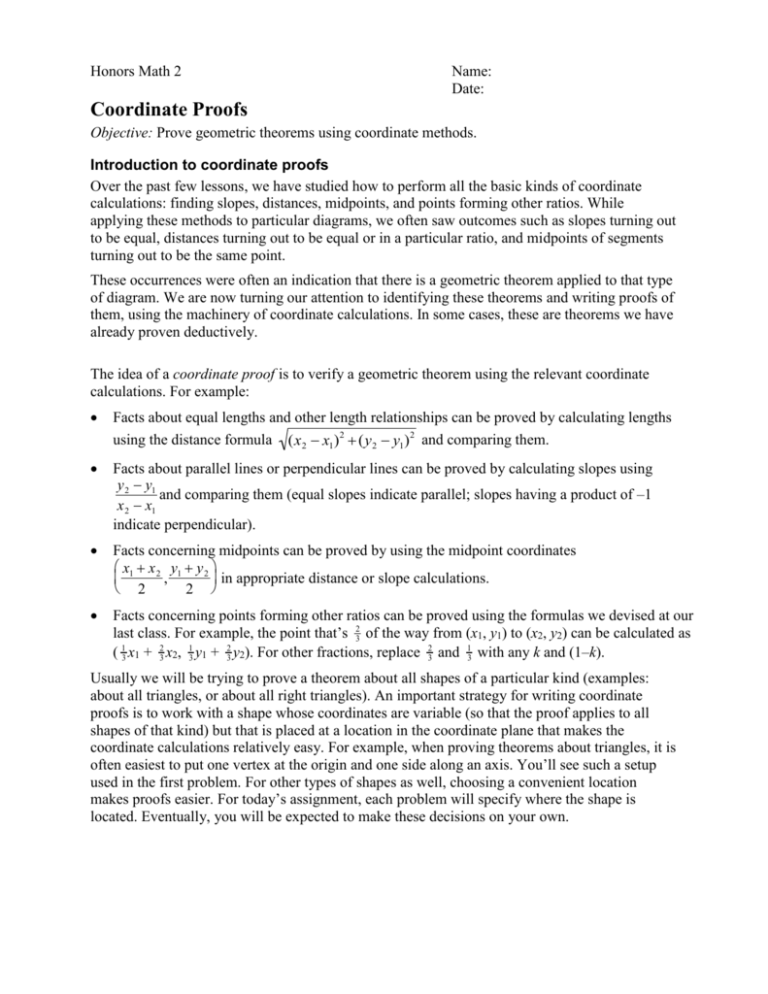
Honors Math 2 Name: Date: Coordinate Proofs Objective: Prove geometric theorems using coordinate methods. Introduction to coordinate proofs Over the past few lessons, we have studied how to perform all the basic kinds of coordinate calculations: finding slopes, distances, midpoints, and points forming other ratios. While applying these methods to particular diagrams, we often saw outcomes such as slopes turning out to be equal, distances turning out to be equal or in a particular ratio, and midpoints of segments turning out to be the same point. These occurrences were often an indication that there is a geometric theorem applied to that type of diagram. We are now turning our attention to identifying these theorems and writing proofs of them, using the machinery of coordinate calculations. In some cases, these are theorems we have already proven deductively. The idea of a coordinate proof is to verify a geometric theorem using the relevant coordinate calculations. For example: Facts about equal lengths and other length relationships can be proved by calculating lengths using the distance formula (x 2 x1)2 (y 2 y1)2 and comparing them. Facts about parallel lines or perpendicular lines can be proved by calculating slopes using y 2 y1 and comparing them (equal slopes indicate parallel; slopes having a product of –1 x 2 x1 indicate perpendicular). Facts concerning midpoints can be proved by using the midpoint coordinates x1 x 2 y1 y 2 , in appropriate distance or slope calculations. 2 2 Facts concerning points forming other ratios can be proved using the formulas we devised at our last class. For example, the point that’s 23 of the way from (x1, y1) to (x2, y2) can be calculated as ( 13 x1 + 23 x2, 13 y1 + 23 y2). For other fractions, replace 23 and 13 with any k and (1–k). Usually we will be trying to prove a theorem about all shapes of a particular kind (examples: about all triangles, or about all right triangles). An important strategy for writing coordinate proofs work with a shape whose coordinates is to are variable (so that the proof applies to all shapes of that kind) but that is placed at a location in the coordinate plane that makes the coordinate calculations relatively easy. For example, when proving theorems about triangles, it is often easiest to put one vertex at the origin and one side along an axis. You’ll see such a setup used in the first problem. For other types of shapes as well, choosing a convenient location makes proofs easier. For today’s assignment, each problem will specify where the shape is located. Eventually, you will be expected to make these decisions on your own. Example Theorem: The midpoint of the hypotenuse in a right triangle is equidistant from the three vertices of the triangle. Proof: Problems Directions: Complete on separate paper. You may wish to use graph paper but it is not required. 1. Consider XYZ with vertices at (0, 0), (a, 0), and (b, c) respectively. Let L, M, and N be the midpoints of the sides, as shown. a. Calculate the coordinates of L, M, and N. b. A segment between midpoints of two sides of a triangle, such as ML, is called a midsegment. Calculate the lengths of midsegment ML and side XY. How do they compare? c. Calculate the slopes of midsegment ML and side XY. How do they compare? d. State the theorem(s) about triangle midsegments that you have proved in parts b and c. e. Now state and prove theorem(s) about all the sides of LMN in relation to all the sides of XYZ. Z(b,c) M X(0,0) L N Y(a,0) 2. For proofs about isosceles triangles (triangles with two equal sides), it’s easiest to put the triangle’s line of symmetry along an axis. a. Draw a graph of a triangle with vertices at (a, 0), (–a, 0), and (0, b). b. Calculate distances to verify that this triangle is an isosceles triangle. c. Find the coordinates of the midpoints of the two equal sides. d. In triangles, a segment from a vertex to the midpoint of the opposite side is called a median. Prove that in an isosceles triangle, two of the medians have equal lengths. 3. Consider the quadrilateral shown in the diagram. a. To make this quadrilateral be a parallelogram, what must coordinate d equal (in terms of the other variables a, b, and/or c)? Hint: In parallelograms, opposite sides always have equal lengths. Make lengths WX and ZY be equal. Z(b,c) W(0,0) Y(d,c) X(a,0) For the rest of this problem, assume that d is as you stated in part a, making the quadrilateral a parallelogram. b. Calculate the coordinates of the midpoint of diagonal WY. c. Calculate the coordinates of the midpoint of diagonal ZX. d. State the theorem you have just proved about the diagonals of a parallelogram. 4. Consider the quadrilateral shown in the diagram. Note that although the coordinate labels are the same as before, we are no longer assuming the fact about d that was in problem 3a. a. Explain why this diagram is an appropriate setup for proving theorems about trapezoids. Z(b,c) W(0,0) Y(d,c) X(a,0) b. Let M be the midpoint of ZW and N be the midpoint of YX. Calculate the slope of MN and the distance MN. c. How does distance MN relate to distances ZY and WX ? d. State the theorem(s) you have just proved about trapezoids. 5. Here is an appropriate coordinate setup to represent quadrilaterals in general. It does not assume that the quadrilateral has any special properties. Z(b,c) Y(d,e) Draw the midpoints of the four sides and connect them to form the midpoint quadrilateral. Write a coordinate proof of this theorem: “Given any quadrilateral, the midpoint quadrilateral must be a parallelogram.” W(0,0) X(a,0)
